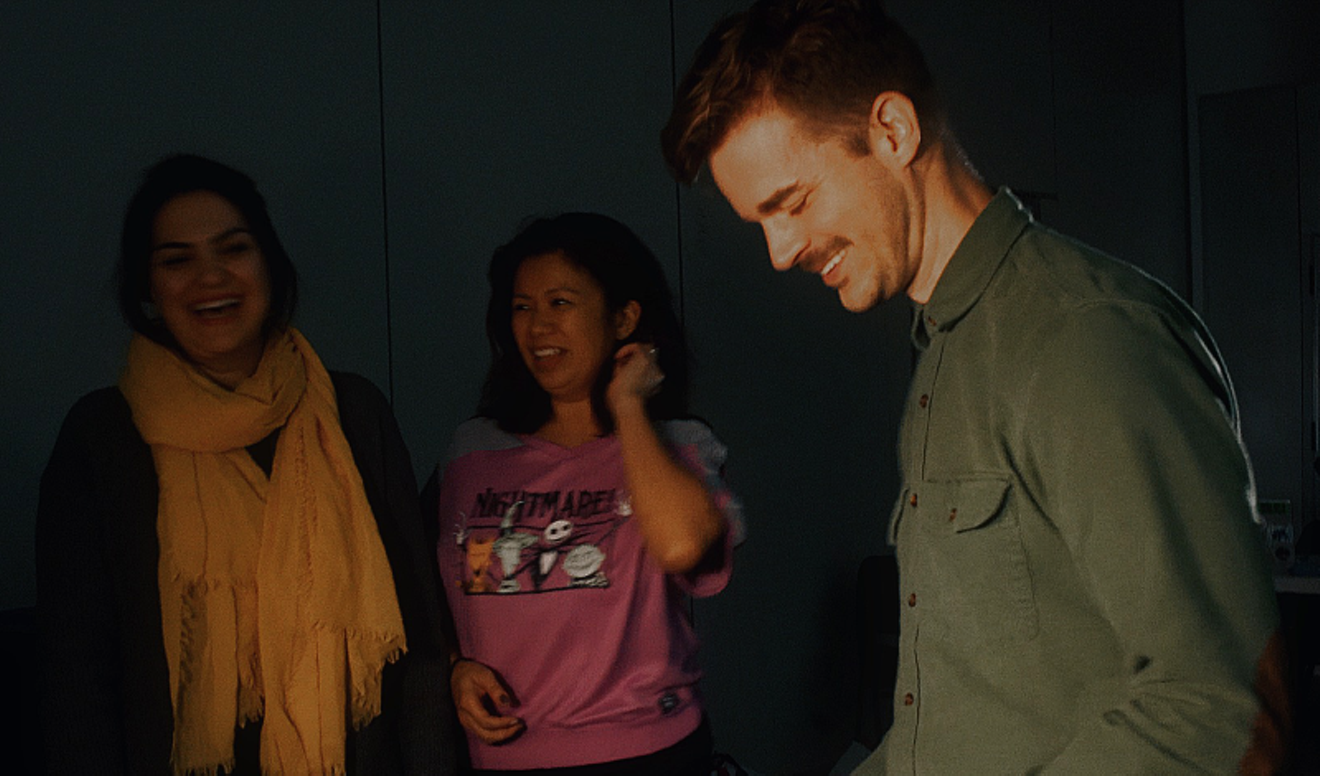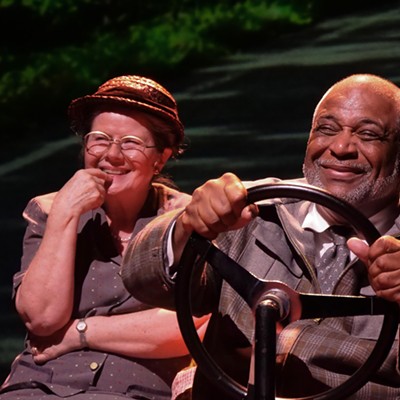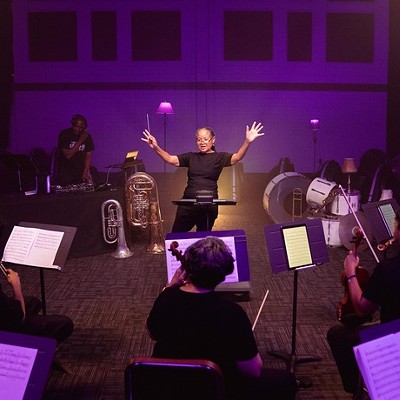Support Us
Houston's independent source of
local news and culture
account
- Welcome,
Insider - Login
- My Account
- My Newsletters
- Contribute
- Contact Us
- Sign out

Afsaneh Aayani, Karina Pal Montaño-Bowers and Adam J. Thompson in the Catastrophic Theatre production of The Turn of the Screw.
Photo by t lavois thiebaud
[
{
"name": "Related Stories / Support Us Combo",
"component": "11591218",
"insertPoint": "4",
"requiredCountToDisplay": "4"
},{
"name": "Air - Billboard - Inline Content",
"component": "11591214",
"insertPoint": "2/3",
"requiredCountToDisplay": "7"
},{
"name": "R1 - Beta - Mobile Only",
"component": "12287027",
"insertPoint": "8",
"requiredCountToDisplay": "8"
},{
"name": "Air - MediumRectangle - Inline Content - Mobile Display Size 2",
"component": "11591215",
"insertPoint": "12",
"requiredCountToDisplay": "12"
},{
"name": "Air - MediumRectangle - Inline Content - Mobile Display Size 2",
"component": "11591215",
"insertPoint": "4th",
"startingPoint": "16",
"requiredCountToDisplay": "12"
}
]
One More 'Turn of the Screw'
by D.L.Groover
Afsaneh Aayani's set design for Catastrophic's world premiere adaptation of Henry James' powerful ghost story The Turn of the Screw (serialized in the American magazine Collier's Weekly, 1898) is wonderfully goth and creepy.
From the get-go, the lobby décor is stuffed with musty Victorian dolls and antique household objects; the theater space at MATCH is swathed in faded red velvet swags; and the entire interior is choc-a-block with more dolls, an old typewriter, period furniture, candlesticks, baby shoes, stereopticons, worn newspapers, old diaries, frayed tomes, skulls, and cabinets heaped with curiosities. A magnificent doll house (which later will be revealed as the mysterious Bly House) rules over the detritus, each detailed room perfectly lit by tiny lights. Tables for the audience punctuate the floor, as if set for a séance, while bleacher seating rings the playing area. Aayani has set the mood perfectly for James' “little novel” of psychological horror. If only Bradley Michalakis' adaptation would get out of the way.
If you're familiar with James' classic novella, you'll recognize the fine bones. A young virginal governess is hired by a rich London man-about-town to shepherd his orphaned nephew and niece, Miles and Flora, at his Essex country estate, Bly House, overlooked by kindly, if secretive, housekeeper Mrs. Grose. The uncle wants no correspondence from her at all. She is to assume total control. At first the children are angels, perfectly mannered, perhaps a bit too perfect, and anyway why has Miles been expelled from school for behavior the headmaster refuses to disclose?
The year before, the former governess, Miss Jessel, had a sordid affair with the disreputable valet Peter Quint. Both have died, and James leads you to believe their ghosts now haunt the children. The new governess thoroughly thinks so – she's seen them! – on the parapets, near the lake, on the staircase, through the grand window. She gradually believes they've come for the children. No one but the governess sees the specters, or so everybody admits to her. She grows ever more protective and defensive of her charges, eventually traumatizing little Flora and sending her away with the housekeeper, while she tempts Miles into confessing his sins at school and, perhaps, his forbidden sins fostered by Quint's evil. When Quint looms at the window again, the governess shields Miles from the view, stopping him from turning around. In so doing, in her steely embrace, suffocates him. Or does he die of fright at the very mention of long-dead Quint?
Wily James, at the height of his literary powers, never lets on. His whole tale is shot through with ambiguity. Yes, ghosts. No, ghosts. Evil versus innocence, or innocence corrupted. Is the governess mad or rational? Is Bly House haunted? These beautiful conundrums are what has kept James' story so relevant through 125 years. Swathed in his thick and rich prose, in turns fragrantly descriptive and deeply probing, Turn of the Screw, told only through the personal narration of the governess many years after the fact, is the forebear of every paranormal tale. Everyone after owes him debt: the secluded old house, children as victims or predators, a female in danger, evil spirits out for no good, things that go bump in the mist, a dark and gloomy night.
Catastrophic's production, “created collaboratively by the Company” but under the co-direction of Aayani, who also designed the set, costumes, and puppets, and Adam J. Thompson who conceived the project and designed the video projections, glosses through James as if it's SparkNotes. We're introduced to the Society for the Advancement of the Psychic Sciences, whose members will document their findings of the case to discover what lies beneath the tale. They will play the story for us in hopes of catching the unexplained, the ineffable. “We are the vessels through which the story is told,” intones the ominous Dr. H. Lovell-Smith (Karina Pal Montaño-Bowers) at the start. This group of ghostbusters has boxes of evidence, from diaries and train tickets, worn photographs, to a modern recording of the ancient music box tune that was associated with Flora.
Ms. Fox (Annie Wild) dons a black Victorian gown and assumes the persona of the Governess. Barduc (John Dunn) plays the Uncle and little Miles, represented by a puppet. Eva C., the spiritualist (Brittny Bush) will play Flora, also a puppet. C. Payson Longley, the Society's musicologist (Hessam Dianpour), will accompany the action with his music (which is quite good, by the way, tingly and eerie with muffled strings, heart-beating drum, and hint of toy piano). The discovery, or séance, if you will, will be videoed by the Mumlers (the spirit photographers), Meagan Smallwood, Ðat Peter Tȯn (associate video designer), and Clarity Welch. A large transparent scrim is framed behind the doll house, upon which is projected impressionistic visuals like the train trip the governess takes to Bly, or cloudscapes, or the actual videos the Mumlers document as we watch. The live action audio is a beat out of sync with the picture, which is either intentional to augment the weirdness or is just out of sync, which is annoying.
The tale rushes through James' mystical highlights, never pausing to allow the tale to envelop us. We're swept from one plot point to the next, while the actors grow more frantic without much explanation as to why they're doing what they're doing. Though the novella is brief – and once you get used to James' knotty sentences and descriptive word play, the tale is a quick read – James overlays it with a musical ebb and flow, letting the everyday scenes build up the tension until those unexpected apparitions jolt us into the extraordinary. There's nothing quite like that here. We're always aware of the scurrying videographers and the fourth wall. James has taken second place to the Society's telling. We miss him dearly.
But the production looks great (the lake at Bly is imagined in a glass-topped bassinet piece into which Barduc pours two pitchers of water and then places a toy boat into it), sounds as good (designer Gage Baker knows his eerie), and even leaves us with a touch of its own ambiguity. Wild, as the governess, is distraught, maybe unhinged, after the death of Miles. She rushes offstage where there's some sort of skirmish as Dr. Lovell-Smith attempts to justify the failed experiment. We will peruse the tapes, she assures. We'll continue to search. She, too, rushes offstage to minister to Wild. Has she died? The end of the Society's tape plays on the scrim. There, but for a brief out-of-focus moment is Quint. He glares at us. Ah, at last, a true touch of James. Now that's spooky.
The Turn of the Screw. Through December 9. 8 p.m. Fridays and Saturdays; 7:30 p.m. Thursdays and Monday, November 27; and 2:30 p.m. Sundays. Catastrophic Theatre at MATCH, 3400 Main Street. For more information, call 713-521-4533 or visit matchhouston.org. No one under the age of 10 permitted for this performance. Tickets pay-what-you-can, suggested price $35.
KEEP THE HOUSTON PRESS FREE...
Since we started the Houston Press, it has been defined as the free, independent voice of Houston, and we'd like to keep it that way. With local media under siege, it's more important than ever for us to rally support behind funding our local journalism. You can help by participating in our "I Support" program, allowing us to keep offering readers access to our incisive coverage of local news, food and culture with no paywalls.
D.L. Groover has contributed to countless reputable publications including the Houston Press since 2003. His theater criticism has earned him a national award from the Association of Alternative Newsmedia (AAN) as well as three statewide Lone Star Press Awards for the same. He's co-author of the irreverent appreciation, Skeletons from the Opera Closet (St. Martin's Press), now in its fourth printing.
Contact:
D. L. Groover
Trending Arts & Culture
- Reviews For The Easily Distracted:
Boy Kills World - Bring a Friend With You to See A.D. Players' Heartwarming Production of Driving Miss Daisy.
- The 10 Best And Most Controversial Hustler Magazine Covers Ever (NSFW)
-
Sponsored Content From: [%sponsoredBy%]
[%title%]

Don't Miss Out
SIGN UP for the latest
arts & culture
news, free stuff and more!
Become a member to support the independent voice of Houston
and help keep the future of the Houston Press FREE
Use of this website constitutes acceptance of our
terms of use,
our cookies policy, and our
privacy policy
The Houston Press may earn a portion of sales from products & services purchased through links on our site from our
affiliate partners.
©2024
Houston Press, LP. All rights reserved.





